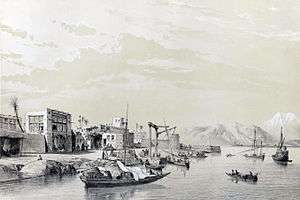Afsharid Conquests in the Persian Gulf & Oman
| Afsharid Conquest of the Persian Gulf | |||||||||
|---|---|---|---|---|---|---|---|---|---|
| Part of Nader's Campaigns | |||||||||
 Bandar-e-Bushehr, historically one of Persia's most important port cities around the Persian Gulf | |||||||||
| |||||||||
| Belligerents | |||||||||
|
Arab Pirates Numerous Arab Sheikdoms Persian Rebels | |||||||||
| Commanders and leaders | |||||||||
|
Nader Shah Mohammad Taqi Khan | Unknown | ||||||||
The Afsharid Conquest of the Persian Gulf was an imperial venture by the Persian Empire, ruled by Nader Shah, to establish Persia as the hegemon of the Persian Gulf and its surroundings. The numerous campaigns that were undertaken were initially very successful and achieved a great many objectives, however, the rebellion of Nader's appointed Darya Salar (Admiral), Mohammad Taqi Khan, wreaked havoc amongst the plethora of polities across the Persian Gulf that had been brought under Persian control. After the defeat and capture of Mohammad Taqi Khan, the Persian empire went through a tumultuous period of unrelenting civil strife and internal war, due to Nader's increasingly brutal rule. The empire collapsed in the immediate aftermath of his assassination, leading to many of these conquests to be lost.[1]
